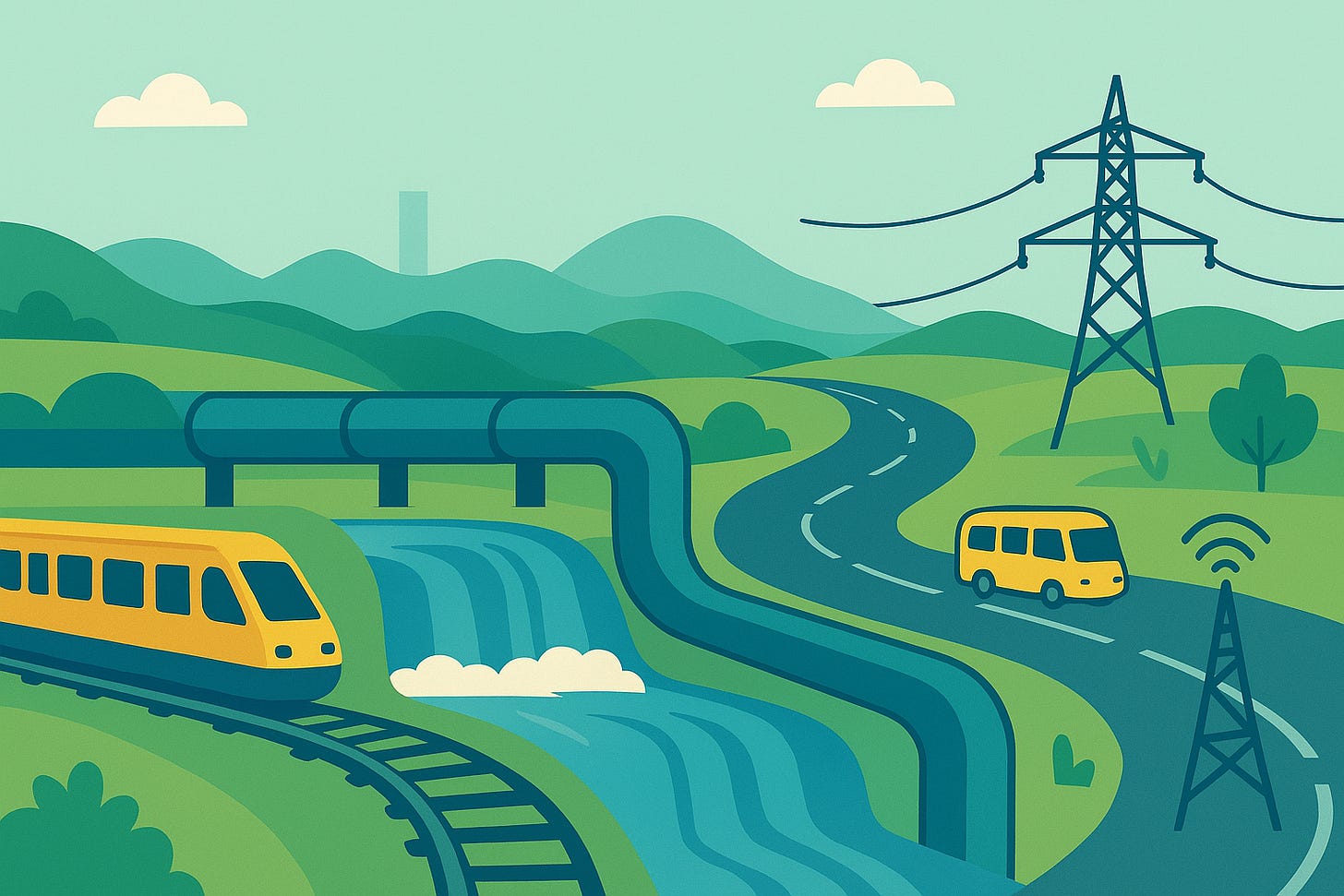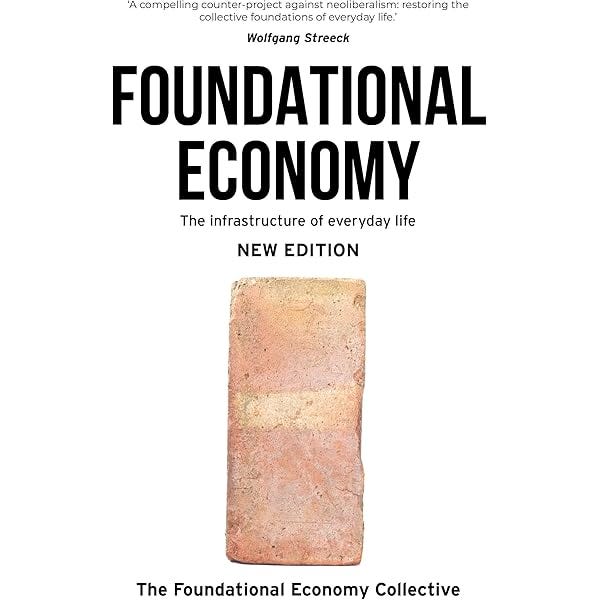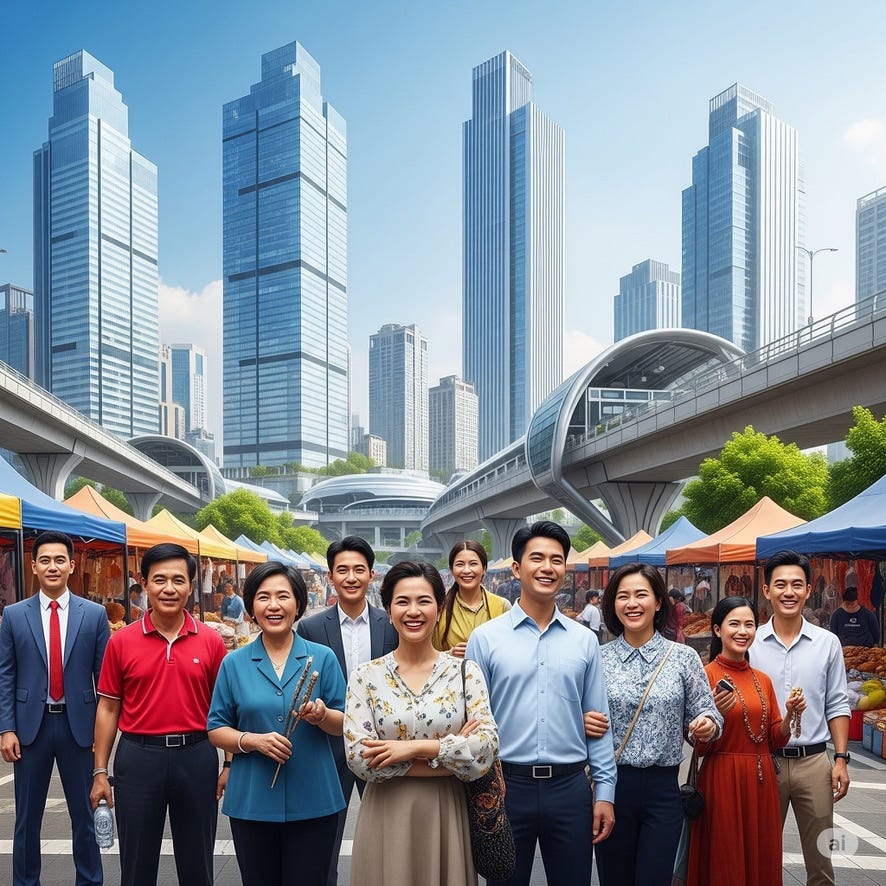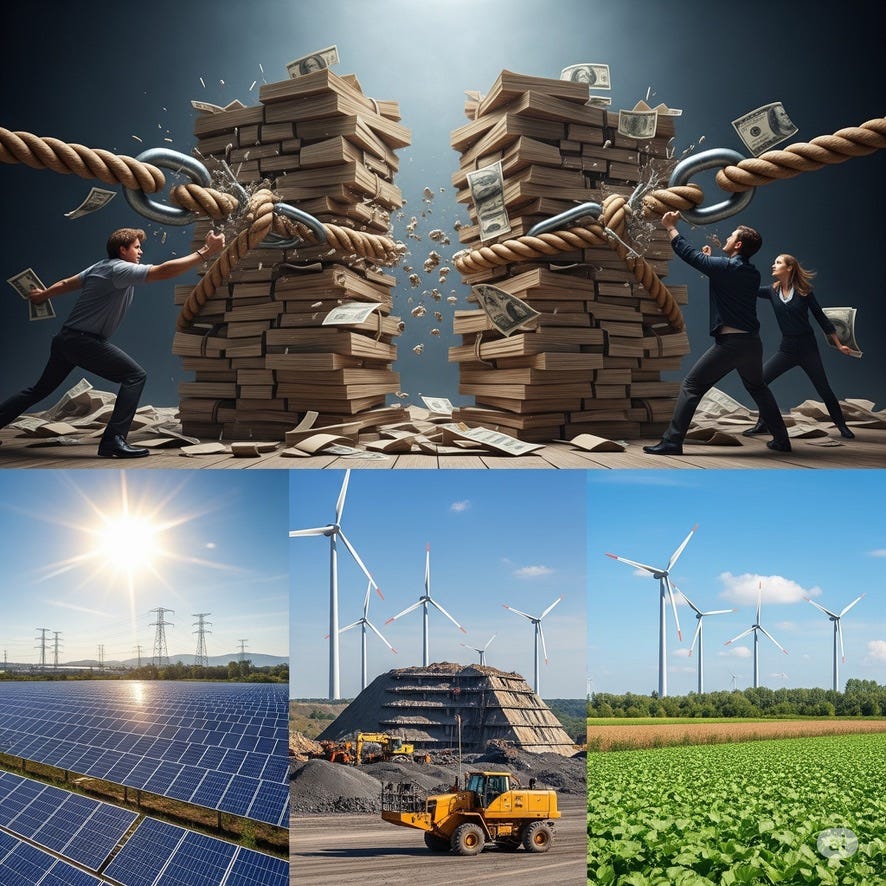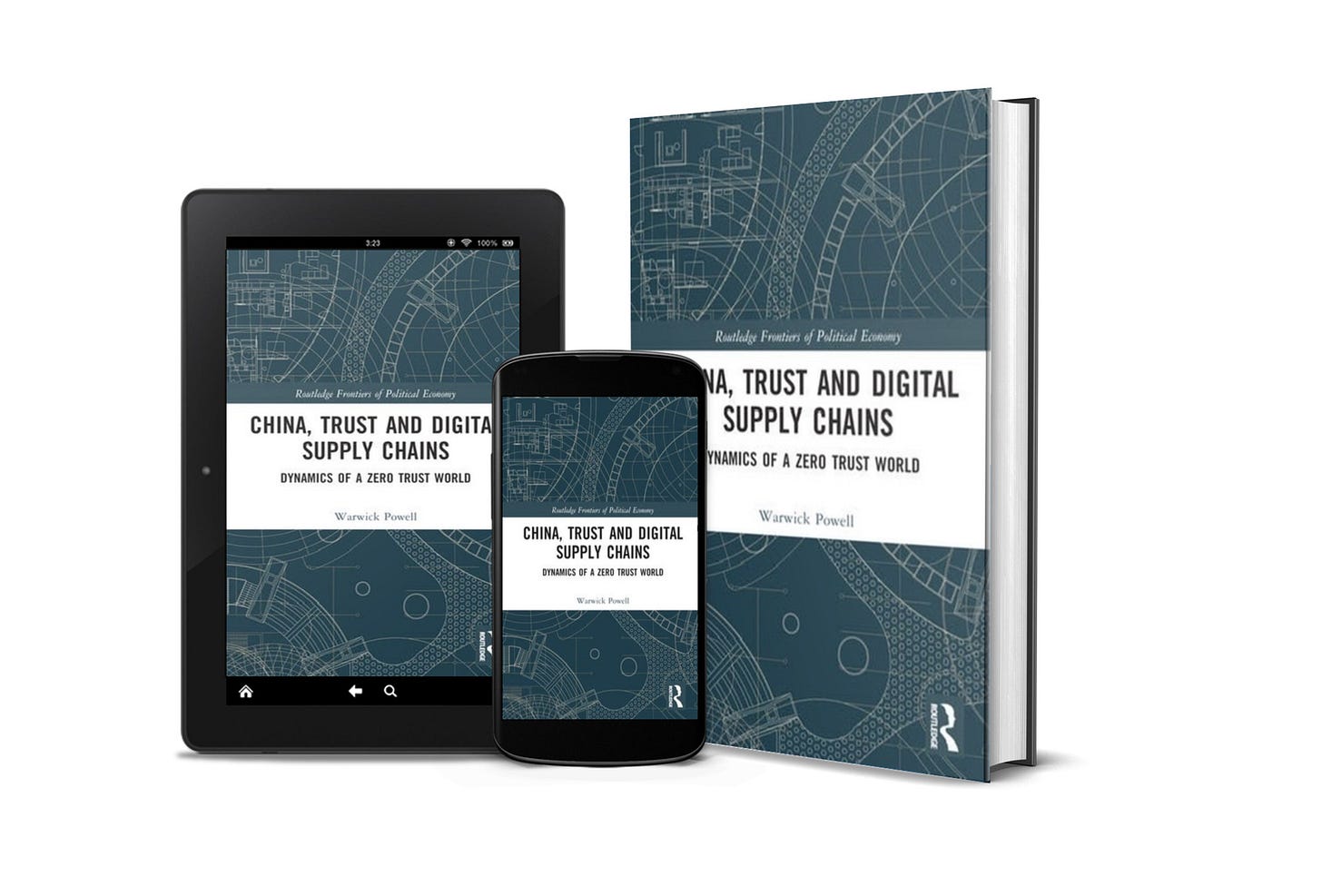From Sexy Sectors to Systemic Value
Energy, Entropy and the Case for the Foundational Economy and Infrastructure of Flow
Preface: This is part of an ongoing series of essays, which draw on a cornerstone paper that proposes some ‘signposts’ of a theory of ‘Systemic Exchange Value’ (SEV) - a geopolitical economy of thermodynamics, information and exchange. The foundational theoretic essay can be accessed here. This present essay extends the foundational thinking by examining its relationship to the so-called ‘foundational economy’. The foundational economy is often overlooked, and if not ignored, it is under-rated at the very least. In financialised capitalism, the foundational economy is often left by the wayside, neglected to fall apart. Yet, in system thermodynamic terms, the foundational economy is central to the success of managing entropy. And China’s social settlement and economic development could very well be the first thermodynamic states.
We live in an era obsessed with what could be called “sexy sectors”; things like cutting-edge tech, high-value exports, speculative finance and unicorn start-ups. These sectors dominate headlines, drive investor interest and shape industrial policy. Yet the real backbone of a functioning society often lies elsewhere: in the foundational economy of care, housing, transport, water, power and public systems.
For years, thinkers like Karel Williams and colleagues at the University of Manchester have argued that the foundational economy deserves more attention, not just for reasons of equity or dignity, but because it makes everyday life possible. It provides the infrastructures and services through which people live, move, work and reproduce. Without it, nothing else flows.
Building on ongoing work in thermodynamics, information theory and ecological macroeconomics, I now extend the work to encompass this foundational economy frame. That’s because it is both morally persuasive and energetically rational. In fact, it is thermodynamically essential. To understand why, we need a new framework. This framework integrates energy, information, infrastructure and distribution into a coherent picture. I have called this framework Systemic Exchange Value (SEV). It shows us, in part at least, that the sectors so many have undervalued for decades are actually high EROEI engines of adaptive capacity.
I begin this essay with a brief reprisal of the SEV framework and its key concepts. Set in this conceptual environment, I then argue that the foundational economy - as discussed by Williams et al - is actually a high Energy Return on Energy Investment (use) (EROEIu) dimension of our social-economic existence. Key to all of this is the provisioning of what I call the infrastructure of flow. (Williams et al call it the “infrastructure of everyday life”). China is then introduced as a case study, before I zoom out to again cast the gaze wider and perhaps a little further.
Systemic Value ≠ Market Value
Mainstream economics defines value in terms of market price, marginal productivity or investor return. But these definitions are blind to the physical processes that make value possible. They ignore energy and entropy. They don’t pay sufficient or any attention to the infrastructure of flow.
The SEV framework starts from a key set of foundational concepts:
Use value is embedded energy (EE), that is, the energy required to produce something;
The viability of any system depends on its energy return on energy invested (EROEI), in both production (EROEIp) and potential use (EROEIu);
Exchange value is a relative claim on EE determined by the vector of EROEIp and EROEIu;
Money is a claim on future EROEI, manifest as Available Energy Potential (AEP); and
Information is both an energetic use value and a potential means of militating against energetic (and other forms of) entropy that undermine the system’s capacity to create and expand the availability of AEP.
Sectors that deliver high EROEIu, that is long-lasting benefit per unit of energy consumed, are foundational to surplus or AEP generation. They’re the unsung multipliers of system-wide adaptive capacity.
The Foundational Economy as High-EROEIu Core
Following Williams and his co-authors, the foundational economy includes sectors like:
Housing;
Utilities (energy and information networks);
Water and waste systems;
Public transport systems and roads;
Schools, hospitals and care systems; and
Everyday provisioning (e.g. supermarkets and food distribution).
These are often dismissed as low-productivity or low-growth sectors. But SEV reframes them as EROEIu-rich. That is, they convert energy into systemic usefulness over long periods with relatively low entropy leakage.
Think of a public water system that provides clean, low-energy access to millions of households daily, for example. Alternatively, we can consider a well-designed public housing complex that reduces heating / cooling costs over decades, and provides people with places to rejuvenate and return to the workforce the next day - that is, a roof over their heads. And of course, as people age, a reliable care infrastructure that lowers long-term health costs, increases social stability and supports labour market participation are critical to minimising social entropy and maximising system adaptive capacity.
These are not “traded” sectors, but they are value-reproductive. They suppress entropy across our social fabric and the economy by keeping people and systems functioning. They are the civic thermodynamics that hold society together. Key to all of this is the infrastructure of flow. I mean by this the physical, digital and institutional systems that allow value, energy, goods, money and information to move efficiently and with low entropy to a point where their proper functioning is best measured by them effectively ‘disappearing’ out of sight. This includes:
Roads, rail and other transport infrastructure that enable the movement of goods and people;
Electricity grids, potable water systems, sewage and broadband networks that connect people to services that they could otherwise not create for themselves, and which rely on scale and scope economies to achieve energy efficiency objectives;
Payment systems, logistics platforms and communications networks that support value flow and directly reduce entropy through improved access to timely and relevant information; and
Standards, legal frameworks and regulatory institutions, which reduce frictions throughout the system of flow.
This infrastructure doesn’t just reduce friction, however. It multiplies the systemic EROEI of everything else. It’s what allows high-energy sectors (like manufacturing or data per se) to coordinate with high-utility sectors (like housing or care). In effect, the infrastructure of flow is a thermodynamic multiplier. It makes other forms of embedded energy more productive and adaptable.
Sexy Sectors vs Systemic Survivability
The irony is that our obsession with high-tech or high-value sectors often blinds us to how fragile their underlying conditions are. Without the foundational economy and the infrastructure of flow, even the sexiest sectors collapse under their own energetic and social burden.
Consider for example the reality that a fintech app is useless if people don’t have housing, power or data access. The same can be said for the latest AI Apps or IOT devices. Alternatively, a medical breakthrough is irrelevant if basic care infrastructure is absent. Or, it’s only useful to a small cohort of people and not others. AI and cloud computing mean little if transport and logistics are unstable, if the aim was for AI to drive supply chain efficiencies.
SEV makes this visible. It recognises that surplus value (EE) cannot circulate without low-entropy foundations. And when foundational systems are degraded by austerity, neglect or privatisation, society doesn’t just become unfair, it becomes energetically unstable. Social entropy intensifies.
Another implication of SEV is that money is a claim on future surplus energy. It is not neutral. When we - as societies - issue credit or spend public funds, we are directing anticipated energy use. If that money flows into low-EROEI speculative or extractive sectors, we amplify systemic entropy. If it flows into foundational systems and infrastructure of flow, we build adaptive capacity.
That means macroeconomic policy must align with thermodynamic logic. In plain terms, consideration needs to be given to credit guidance that channels public investment toward long-duration, high-EROEIu sectors. Public finance for civic infrastructure and entropy-suppressing systems is not wasteful but foundational. Strategic investment in informational infrastructure that increases EROEIu (e.g., digital coordination, smart utilities and public platforms) is pivotal, subject to the satisfaction of the conditions of information viability (a topic to which I shall return in another essay).
China as a Thermodynamic State
Let’s illustrate these general observations by considering the case of China. (For a more detailed overview of an alternative interpretation of the China growth experience, see my earlier essay here.)
As many debate whether China’s growth model is sustainable, many analysts are looking in the wrong place. Those familiar with my work will know that this has long been one of my bugbears. Obsessed with real estate bubbles, trade imbalances, the prevalence of State Owned Enterprises that are pilloried as ‘inefficient’ or the supposedly tardy pace of tech innovation, they overlook a more profound truth: China is not just building an increasingly sophisticated and complex economy, it is building a thermodynamic system.
China is in effect designing an economy around the principles of energy transformation, circulation efficiency and entropy suppression. It is not merely pursuing GDP growth or competitive exports. It is seeking to construct a systemic exchange value regime that maximises energy return over time, distributes surplus through high-utility infrastructures and maintains social and institutional coherence in the face of long-run shocks. I suspect this is, at a certain level, even if it’s not explicitly articulated in these terms, what is meant by the notion of ‘high quality development’.
This makes China a thermodynamic state that recognises that modern power arises from the capacity to mobilise, store and circulate energy in the most adaptive and entropy-resistant way possible.
Rethinking Economic Power Thermodynamically
What do we mean by a thermodynamic economic system? Using the Systemic Exchange Value (SEV) framework, we understand value not as price, productivity or demand, but as embedded energy (EE) that must be transformed and circulated with maximum energy return on energy invested (EROEI). What matters in this view is not just the generation of surplus, but its thermodynamic viability: can it be distributed, reused and reinvested to sustain collective systems over time?
Seen in these terms, China’s model becomes much clearer and more strategic.
Thermodynamic circulation capacity
China has spent decades building its infrastructure of flow.
It has the most expansive infrastructure ecosystem in the world. It has developed the world’s most extensive high-speed rail and integrated logistics. Many conventional western commentators lambasted the investment in high-speed rail, claiming that it represented chronic waste. Perhaps in conventional accounting terms, an argument could be mustered, but in thermodynamic terms, the investment is likely to pay off in spades.
Forty years ago, much of the country had little to no electricity. Even major cities experienced regular scheduled and unscheduled power outages. Not today. China has the world’s largest electricity grid that increasingly integrates data analytics to support grid optimisation. The grid transmits energy generated from a growing array of energy generation sources, and is now buttressed by an expanding network of energy storage systems. China has over time developed an energy system that operates with reserve margins of between 80-100%; that is, it has plenty of energy capacity ‘up its sleeve’ to enable rapid development in electricity intensive activities (such as data centres and artificial intelligence, where it faces no energetic constraints - see this recent report in Fortune) and to absorb unexpected surges in demand arising from industrial transformation via robotics and the like.
Urban transport, sewerage and water systems have been part and parcel of 40 years of rapid urbanisation. Effective urbanisation simply cannot take place without substantial investments in these foundational infrastructure and services. The emergence of the so-called low altitude economy is another dimension of reducing friction in the infrastructure of flow - enabling products and people to get from A to B quickly.
Digital infrastructure from industrial and retail 5G to the progressively trial rollout of the digital yuan are features of a country that is not only at the leading edge of many aspects of technological innovation but is arguably the world’s most successful adopter of technology into social and industrial workflows. And now, China has announced a roadmap for the digitalisation of national supply chains anchored by AI, IOT and blockchain technologies. I discussed this in a recent interview with Glenn Diesen on his channel, and for those interested in China’s adoption of blockchain technologies, my book China, Trust and Digital Supply Chains (2023) may be of interest.
These systems do more than enable commerce. They reduce coordination entropy across the economy. They ensure that energy, people, goods and information circulate efficiently. In SEV terms, they amplify EROEI by minimising friction in the movement of value. Critics call some of this “overbuilding.” A more accurate description might be: investment in thermodynamic circulation capacity.
Entropy suppression infrastructure
China has prioritised the foundational economy. China’s urbanisation, public housing expansion, community health systems and education infrastructure are often dismissed as state-heavy or inefficient. But these are high-EROEIu sectors because they produce stability, reproducibility and human capacity over decades with relatively low marginal energy input.
These systems don’t just support consumption. They extend surplus lifespan, reduce volatility and anchor long-term coordination.
With projects like the digital yuan, smart grid control systems, and increasingly AI-optimised logistics, China is treating information as a structural layer of energy efficiency. The more a system knows about its own state, the less energy it wastes. This is not just monetary planning. Rather, it is thermodynamic alignment of credit and surplus. In SEV terms, they are entropy suppression infrastructures.
Thermodynamic alignment of credit and surplus
Unlike Western systems where credit is largely privately controlled and often flows into speculative or low-EROEI sectors (e.g. financial arbitrage, luxury real estate), China has a coordinated money strategy that uses its central monetary institutions to create anticipatory liquidity for infrastructure and foundational projects, guide credit to sectors aligned with national productive and energy goals via its state-owned policy banks and maintains control over payment systems to increase informational coherence and dependability.
In SEV terms, this represents an intentional reduction of informational entropy, enabling a more energy-efficient and dynamically coordinated economy.
Behind China’s strategy lies a deeper insight: that modern statecraft is about entropy management. China’s is a systemic approach to entropy retardation. Chinese statecraft addresses physical entropy which threatens infrastructure, climate and production systems. It aims to enhance the means by which the system as a whole deals with informational entropy that threatens governance, coordination and foresight.
And through a focus on the foundational economy, it also seeks to ameliorate risks of social entropy that threatens social stability. China’s long-termism, through its planning institutions, can also be seen as a civilisational commitment to entropy retardation. This is buttressed by an evolving apparatus of scaffolded democratic institutions, which seek to maintain proximity between those responsible for making public-good decisions and the wider population. Here, China’s evolving ‘whole process democracy’ draws as much from Durkheim’s insights, expressed in his less-well known Professional Ethics and Civic Morals, as it does from the legacies of Leninist party building.1 The goal is not permanent equilibrium - an oxymoron when one’s foundational ontology is premised on the persistence of change, but the construction of a system capable of absorbing shocks, redistributing energy intelligently and maintaining adaptive flow over long durations.
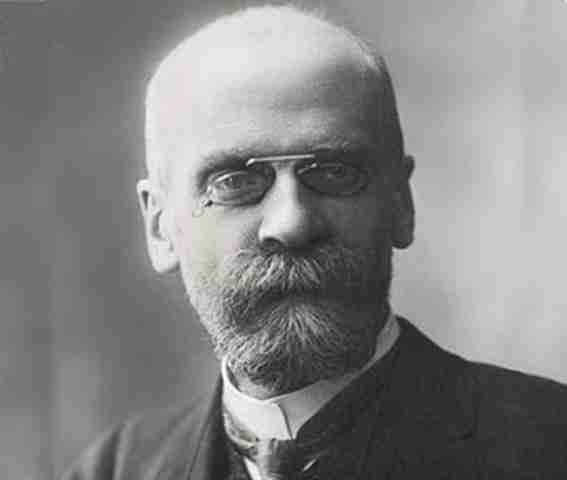
Toward a Thermodynamic Social Settlement
All economies rest on a social settlement. This is a set of assumptions and agreements about how value is created and shared. A sustainable social settlement understands and values surplus energy not just in production but in use and circulation. It recognises infrastructure and care as central to adaptive capacity, and treats surplus distribution (via wages, services or infrastructure) as a system-reproductive act. Inherently, therefore, it designs institutions to manage entropy, not just optimise margins or returns for one privilege stakeholder or class. This is a form of systemic realism that is grounded in the material, informational and energetic dynamics that actually determine whether societies survive, stabilise, prosper or collapse.
We need to move from GDP metrics to EROEI accounting, as I argued recently. This shifts the gaze from speculative returns to systemic value, from total obsessions with sexy sectors to considered commitments to foundational flows. It is time to revalue the mundane, not just for fairness, but for thermodynamic sustainability. The future of economic strategy lies not in where the market is hot - memecoins come to mind - but in where entropy is suppressed, flow is enabled and smoothed and lives are sustained through the creation and distribution of surplus energy. In the coming decades, the real measure of economic power will not be who dominates technology or controls shipping lanes per se. It will be which nations can increase EROEI, suppress entropy and distribute surplus energy efficiently across space and time. Technology and shipping are merely just some of the tools.
By this measure, China’s strategy may be more forward-looking than it appears; less ‘wasteful’ than claimed. It is building a system not just to grow but to endure. That, in the end, is the most profound form of power: not domination, but dynamic viability.
See my chapter in Yu, Haiqing and Creemers, Rogier eds (2025) Automating Governance in China? Data driven systems in the scoring society, Leiden University Press in which I discuss how Chinese intellectuals are discussing blockchain technologies in the context of enhanced social governance. Here, I explore how these discussions are in effect exploring some of the ways in which those proximity challenges discussed by Durkheim can be addressed by way of new distributed ledger technologies so as to ‘give life’ to new ethos of democratic governance.


